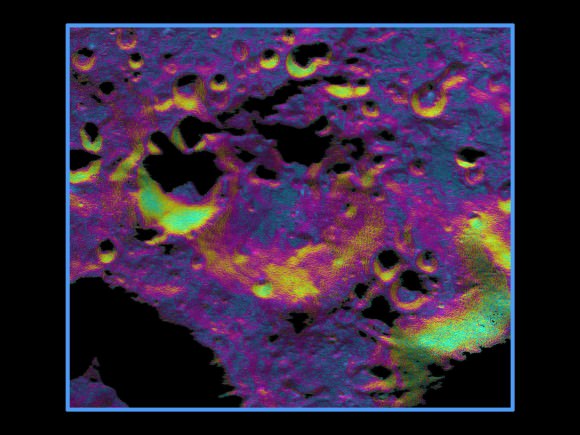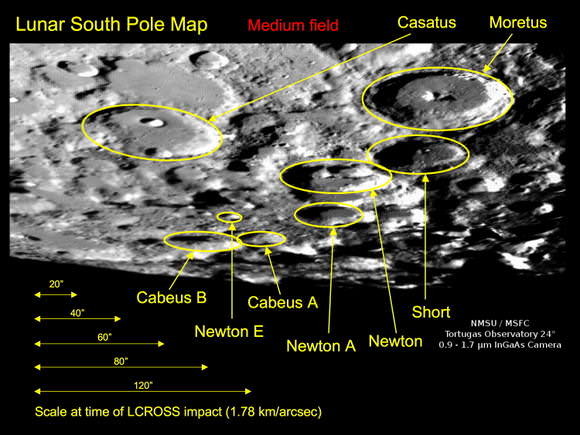[/caption]
On October 9, 2009, at 7:30 a.m. EDT professional and amateur astronomers alike will be focusing their telescopes on the south pole of the Moon, hoping to see a little fireworks. Or more accurately, they are hoping to see ice. NASA will be sending the upper stage of a Centaur rocket to impact a permanently shadowed crater, along with the Lunar Crater Observation and Sensing Satellite, or LCROSS which will fly into the plume of dust left by the impact and measure the properties of the dust to look for water ice hidden inside the crater. LCROSS will collide with the lunar surface. Team scientists have been debating what crater would be the optimal location for the impact, and today they made their announcement: Cabeus A.
And just to clarify, the spacecraft will impact the Moon, NOT bomb it. No detonations involved.
The LCROSS team selected Cabeus A based on a set of conditions that include proper debris plume illumination for visibility from Earth, a high concentration of hydrogen, and mature crater features such as a flat floor, gentle slopes and the absence of large boulders.
“The selection of Cabeus A was a result of a vigorous debate within the lunar science community that included review of the latest data from Earth-based observatories and our fellow lunar missions Kaguya, Chandrayaan-1, and the Lunar Reconnaissance Orbiter,” said Anthony Colaprete, LCROSS project scientist and principle investigator at NASA’s Ames Research Center in Moffett Field, Calif. “The team is looking forward to the impacts and the wealth of information this unique mission will produce.”

“LCROSS will shepherd the Centaur to the precise orbit, and accelerate it into the moon,” said LCROSS project scientist Tony Colaprete. “The two will separate, with LCROSS following the Centaur by four minutes, taking live “bent pipe” measurements, sending back live video (which will be shown live via webcast) taking measurements of the lunar regolith characteristics, looking for lunar water vapor or ice characteristics, then impacting the lunar surface itself. LCROSS will be a smashing success.”
Observatories involved the observing campaign include the Infrared Telescope Facility and Keck telescope in Hawaii; the Magdalena Ridge and Apache Ridge Observatories in New Mexico and the MMT Observatory in Arizona; the newly refurbished Hubble Space Telescope; and the Lunar Reconnaissance Orbiter, among others.
“These and several other telescopes participating in the LCROSS Observation Campaign will provide observations from different vantage points using different types of measurement techniques,” said Jennifer Heldmann, lead for the LCROSS Observation Campaign at Ames. “These multiple observations will complement the LCROSS spacecraft data to help determine whether or not water ice exists in Cabeus A.”
The impact should be visible to people in the United States and Canada — the farther west the better.
Learn about the observing campaign for amateur astronomers here.
During a media briefing Sept. 11, Daniel Andrews, LCROSS project manager at Ames, provided a mission status update indicating the spacecraft is healthy and has enough fuel to successfully accomplish all mission objectives despite an anomaly that caused the spacecraft to spend an excessive amount of fuel.
Andrews also announced the dedication of the LCROSS mission to the memory of legendary news anchor, Walter Cronkite, who provided coverage of NASA’s missions from the beginning of America’s manned space program to the age of the space shuttle.
Source: NASA


awsome. i’m right in the sweet zone. no clouds please…
Bombing! Now there’s a top idea! Just pack a few hundred kilos of semtex into a specially created bunker-buster shell, and BOMB THE MOON! None of this mamsy pamsy impactor business – real space agencies bomb stuff.